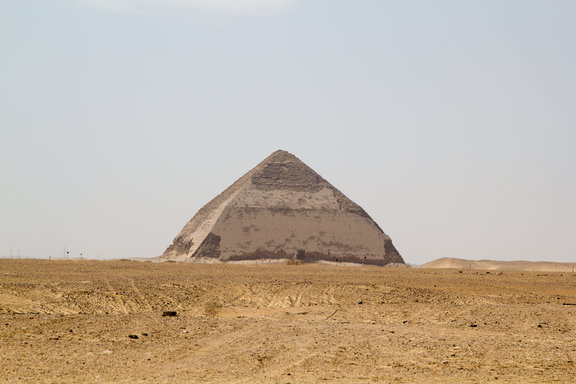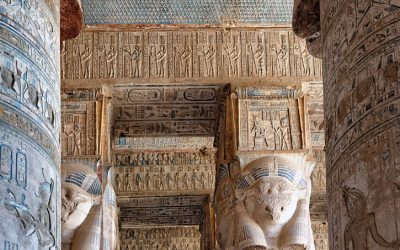Historical Context of the Bent Pyramid
The Bent Pyramid of Egypt, situated at Dahshur, is a remarkable example of ancient Egyptian architecture and ingenuity. Built during the reign of Pharaoh Snefru in the 27th century BCE, it represents a transitional phase in pyramid construction, exemplifying the evolution from step pyramids to the true smooth-sided pyramids. Its unique irregular shape reflects both architectural experimentation and shifting engineering techniques of the period, which played a crucial role in the development of later monumental structures in ancient Egypt.
Construction Timeline and Pharaoh Significance
The Bent Pyramid of Egypt, built during the Fourth Dynasty of the Old Kingdom, represents a significant milestone in ancient Egyptian architecture and royal history. Its construction reflects the technological advancements and architectural experimentation of the time, marking a transition from stepped structures to smooth-sided pyramids. The pyramid’s unique bent shape is believed to result from structural issues during construction, highlighting the builders’ adaptation to engineering challenges.
The construction of the Bent Pyramid began around 2600 BC under Pharaoh Snefru, who was eager to perfect the pyramid design and ensure its stability. The project took approximately 20 years to complete, signifying the scale and complexity involved in such monumental architecture. The pyramid’s initial inclination was planned to be at a steeper angle, but due to concerns about stability, the angle was lowered partway to create its distinctive bent appearance. This construction timeline underscores the iterative process of ancient Egyptian engineering and the importance placed on royal tombs.
Pharaoh Snefru, the father of Khufu and founder of the Fourth Dynasty, holds great significance in Egyptian history for his innovative approach to pyramid construction. His efforts to perfect pyramid design culminated in the creation of the Bent Pyramid, which influenced subsequent pyramids and demonstrated his commitment to achieving architectural perfection. The pyramid not only served as a royal tomb but also symbolized the enduring power and divine authority of the pharaoh, reinforcing the spiritual and political stability of Egypt during his reign.
Architectural Innovations and Challenges
The Bent Pyramid of Egypt, constructed during the reign of Pharaoh Snefru around 2600 BCE, represents a significant milestone in ancient Egyptian architecture. Its historical context reflects a period of experimentation in pyramid design as builders sought to achieve greater stability and grandeur in royal tomb construction. This pyramid marks a transitional phase from the traditional step pyramids to the smooth, true pyramids that would follow, highlighting Egypt’s evolving architectural ambitions.
Architectural innovations in the Bent Pyramid include its unique two-phase construction approach, where the angle of the slope was initially steeper and later adjusted to a more gentle incline. This change was likely in response to structural challenges, as the earlier steep sections showed signs of instability. The pyramid’s design demonstrates an innovative solution to balancing height, stability, and aesthetic perfection, setting a precedent for future monumental structures.
The construction of the Bent Pyramid also faced significant challenges. The primary issue was ensuring the stability of such a massive structure while maintaining the desired form. Engineers and architects had to address problems related to weight distribution, foundation strength, and material durability. The decision to alter the angle partway through construction exemplifies the adaptive problem-solving that was necessary, ultimately leading to the successful completion of a pyramid that influenced subsequent designs. This structure embodies both the technological ingenuity and the perseverance of ancient Egyptian builders in overcoming architectural obstacles.
Architectural Features of the Bent Pyramid
The Bent Pyramid of Egypt is a remarkable architectural marvel that showcases the ingenuity of ancient Egyptian engineering. Built during the reign of Pharaoh Snefru around 2600 BCE, it is distinguished by its unique angled structure and innovative design. This pyramid represents a transitional form between the traditional straight-sided pyramids and the more advanced smooth-sided constructions, highlighting the evolution of funerary architecture in ancient Egypt.
Design and Structural Characteristics
The Bent Pyramid of Egypt is renowned for its unique architectural features and innovative design, representing a significant advancement in pyramid construction during the Fourth Dynasty. It features a distinctive change in angle partway up its structure, which is a notable characteristic that differentiates it from earlier smooth-sided pyramids. This alteration was likely a response to structural concerns, showcasing the engineers’ evolving understanding of stability and load distribution.
The pyramid’s core is constructed with large limestone blocks, arranged in horizontal courses, providing a sturdy foundation. Its exterior originally featured smooth, polished limestone casing stones, although many have been lost over time. The design incorporates a stepped profile that transitions into a sleeker pyramid shape, with the lower section built at a steeper angle that gradually shifts to a gentler incline higher up, creating the “bent” appearance from afar.
Structurally, the Bent Pyramid demonstrates advanced techniques such as internal galleries and corridors, including the burial chamber and descending passages, which were carefully positioned to align with astronomical and religious considerations. Its massive bulk and geometric precision exemplify the Egyptians’ mastery in combining aesthetics with functionality, while its unique angle change embodies early experimentation in pyramid engineering that influenced subsequent constructions.
Unique Angles and Modifications
The Bent Pyramid of Egypt is renowned for its unique architectural design, which distinguishes it from other pyramids of the same period. Its construction features a distinctive change in angle partway up the structure, creating a bent appearance. This shift is believed to have been a strategic modification to ensure stability, as the initial steeper angle may have compromised the pyramid’s integrity. The pyramid originally exhibits angles of approximately 54 degrees at the lower section, which transition to around 43 degrees higher up. This careful adjustment in angles reflects the builders’ advanced understanding of structural engineering and their efforts to prevent collapse. Additionally, the Bent Pyramid incorporates innovative modifications such as internal corridors and chambers that were designed with precision. Its unique angles and structural modifications exemplify the Egyptians’ engineering ingenuity, making it a significant architectural marvel that showcases both functional and aesthetic considerations in ancient Egyptian architecture.
Construction Techniques and Materials Used

The Bent Pyramid of Egypt stands as a remarkable example of ancient construction techniques and material usage. Its unique design reflects the advanced engineering skills of the ancient Egyptians and their ability to work with available resources. Exploring the methods and materials used provides valuable insight into the architectural innovations that made this iconic structure possible.
Stone Selection and Quarrying Methods
The Bent Pyramid of Egypt is a remarkable example of ancient construction techniques and material selection, showcasing the ingenuity of early pyramid builders. Its unique shape results from a combination of architectural innovation and careful material choice, which contributed to the stability and durability of this ancient structure.
In constructing the Bent Pyramid, the Egyptians employed large blocks of locally available limestone, which were quarried from nearby sources. The quarrying process involved extracting massive stones using copper tools and wooden sledges, followed by shaping and transporting these blocks to the construction site. The quality of stone was crucial to ensure the pyramid’s longevity and withstand environmental conditions over millennia.
The construction techniques used include the careful stacking of massive stone blocks in horizontal courses, with interlocking joints to improve stability. Builders gradually increased the incline angle during construction, initially following a steeper slope that was later altered to prevent structural failure, resulting in the distinctive bent shape. Sophisticated planning and alignment methods, likely using simple tools like plumb bobs and leveling instruments, allowed for precise placement and orientation of the stones.
- Stone Selection
- Quarrying Methods
- Construction Techniques
Overall, the combination of strategic stone selection, efficient quarrying, and innovative construction techniques enabled the ancient Egyptians to build the Bent Pyramid as a durable and architecturally significant monument that continues to intrigue historians and archaeologists today.
Labor and Engineering Strategies
The Bent Pyramid of Egypt exemplifies an advanced understanding of construction techniques and materials used in ancient Egypt. Built during the reign of Pharaoh Snefru, it features large limestone blocks carefully cut and fitted together, utilizing durable locally sourced materials such as limestone and granite. These materials provided structural stability and longevity, crucial in the pyramid’s unique bent design. Ingenious engineering strategies were employed to address the challenges of creating a pyramid with changing angles, involving stepped core constructions and precise geometric planning. Labor was organized into skilled craftsmen and massive workforces, utilizing simple tools like copper chisels, wooden sledges, and leverage devices to transport and position heavy stones. Innovative strategies, including the use of ramps and scaffolding, facilitated the construction process, enabling the building of this complex structure over many years. Overall, the combination of durable materials and sophisticated engineering tactics highlights the Egyptians’ remarkable ingenuity and mastery of construction during the Old Kingdom period.
Historical Significance and Cultural Impact
The Bent Pyramid of Egypt stands as a remarkable testament to ancient Egyptian engineering and architectural innovation. Its unique design reflects the evolving techniques and understanding of construction during the Fourth Dynasty, making it a vital part of Egypt’s historical narrative. Beyond its structural significance, the pyramid also embodies the cultural and religious values of the time, symbolizing the divine power of the pharaoh and his journey to the afterlife. Its enduring presence continues to influence modern perceptions of Egypt’s rich cultural heritage and historical legacy.
Symbolism and Religious Beliefs
The Bent Pyramid of Egypt is an architectural marvel that holds profound historical and cultural significance, reflecting the ingenuity and religious beliefs of ancient Egyptian society. It symbolizes the evolution of pyramid construction techniques and showcases the transition from traditional straight-sided pyramids to the more stable bent design, indicating the Egyptians’ adaptability and pursuit of divine harmony.
In terms of symbolism and religious beliefs, the Bent Pyramid embodies several key concepts rooted in Egyptian spirituality. It is believed to symbolize the spiritual ascent of the pharaoh toward the afterlife, representing the union of the earthly and divine realms. The pyramid’s unique shape is thought to reflect the ancient Egyptians’ understanding of the cosmos, with its angles and structure aligning with their religious worldview.
- Amplification of the Pharaoh’s divine status, connecting him with the gods
- Representation of the cosmic order and the journey of the soul towards eternal life
- Significance of the pyramid shape as a divine staircase reaching toward the heavens
- Symbolic transition from the mortal realm to the divine realm
- The Bent Pyramid’s design demonstrates the Egyptians’ religious devotion and their desire to ensure the successful passage of their ruler into the afterlife.
- Its construction reflects spiritual symbolism tied to the Egyptian worldview, emphasizing the importance of stability, harmony, and divine authority.
- Ultimately, the pyramid serves as a lasting testament to the cultural and religious aspirations of ancient Egypt, cementing its place in history as an enduring icon of spiritual symbolism and cultural identity.
Influence on Subsequent Pyramid Constructions
The Bent Pyramid of Egypt holds profound historical significance as one of the earliest large-scale stone pyramids, marking a pivotal transition in ancient Egyptian architectural development. Its unique structural design reflects the evolving engineering techniques and the experimentation in pyramid construction during the reign of Pharaoh Snefru. The pyramid’s distinctive bent shape showcases an innovative approach to stability and construction challenges faced by early builders.
This pyramid’s cultural impact is notable as it represents a crucial step in the evolution of royal tombs, influencing both contemporary and subsequent pyramid designs. It exemplifies the Egyptians’ mastery of monumentality and offers insight into their religious and funerary practices centered around immortality and divine kingship. The Bent Pyramid also symbolized the Pharaoh’s divine authority and was part of a broader religious landscape emphasizing the afterlife.
- The Bent Pyramid served as a prototype for later, more refined pyramids, demonstrating the importance of structural experimentation in ancient architecture.
- Its unique shape inspired subsequent pyramid designs, including the Red Pyramid, which adopted a more conventional slope but retained the innovative spirit of Snefru’s architectural experiments.
- The structural techniques developed during its construction contributed to the mastery seen in the Great Pyramid of Giza, setting architectural standards for subsequent eras.
- The pyramid’s innovative construction methods reflected a shift toward more sophisticated engineering practices, influencing not only pyramid construction but broader Egyptian architectural endeavors.
Preservation and Modern Discoveries
The Bent Pyramid of Egypt stands as a remarkable testament to ancient engineering and the ongoing efforts to preserve our historical heritage. Recent discoveries and preservation initiatives have shed new light on its construction techniques and historical significance. Exploring these modern advancements allows us to better understand the ingenuity of ancient Egyptian architects and ensures the preservation of this iconic monument for future generations.
Restoration Efforts and Conservation Challenges
The Bent Pyramid of Egypt stands as a remarkable testament to ancient Egyptian engineering and architectural innovation. Over centuries, preservation and modern discoveries have played crucial roles in understanding its historical significance. Restoration efforts aim to stabilize the structure and prevent further deterioration, while conservation challenges often stem from environmental factors and the natural aging of materials.
Modern discoveries continue to shed light on the pyramid’s construction techniques, purpose, and historical context. These findings have led to improved preservation methods and a deeper appreciation of Egypt’s ancient engineering prowess. However, these efforts face numerous challenges, including environmental erosion, human impact, and the delicate nature of ancient building materials. Sustainable conservation strategies are essential to ensure that the Bent Pyramid remains a vital cultural heritage site for future generations.
- Investigations using non-invasive imaging technologies have revealed hidden chambers and structural details.
- Research into ancient mortar compositions helps in designing compatible restoration materials.
- Continuous monitoring systems are employed to detect structural shifts or damage early.
- Environmental control measures aim to mitigate weather-related deterioration.
- Public awareness and controlled tourism are managed to reduce human-induced harm.
Recent Archaeological Findings
The Bent Pyramid of Egypt is one of the most intriguing archaeological discoveries, offering insight into ancient Egyptian engineering and construction techniques. Recent excavations and studies have unveiled new details about its construction, purpose, and the people who built it. These findings help deepen our understanding of the Old Kingdom period and the evolution of pyramid design.
Recent archaeological discoveries around the Bent Pyramid have included the unearthing of well-preserved burial chambers, artifacts, and intricate inscriptions that shed light on the burial practices and religious beliefs of the time. Preservation efforts have focused on stabilizing the structure and conserving the surrounding limestone casing, which had suffered from erosion and previous attempts at restoration.
Modern research techniques, such as 3D scanning and mineral analysis, have provided new evidence about the pyramid’s original appearance and the materials used in its construction. These discoveries not only enhance our appreciation of ancient Egyptian craftsmanship but also demonstrate the importance of ongoing preservation to protect these invaluable cultural treasures for future generations.
Tourism and Accessibility
The Bent Pyramid of Egypt is a fascinating historical monument that attracts numerous visitors from around the world. Ensuring accessibility for all travelers is essential to allow everyone to experience its architectural grandeur and cultural significance. Enhancing tourism by accommodating diverse needs not only promotes inclusivity but also enriches the overall visitor experience at this iconic site.
Visitations and Guided Tours
The Bent Pyramid of Egypt stands as a remarkable example of ancient engineering and is a popular destination for tourists interested in Egypt’s rich history. Accessibility to such historical sites has improved over the years, allowing visitors with diverse needs to explore the monument. Guided tours often include detailed explanations of the pyramid’s unique structural features and its historical significance, enhancing the visitor experience. These tours typically provide insights into the construction techniques and the archaeological discoveries associated with the site. Efforts to promote accessibility and informative visits have made the Bent Pyramid an accessible and engaging destination for travelers from around the world.
Visitor Impact and Preservation Measures
The Bent Pyramid of Egypt stands as a fascinating example of ancient engineering and architectural innovation, attracting countless tourists from around the world. As a popular historical site, it experiences significant visitor numbers, which can lead to environmental and structural impacts. To preserve this iconic monument, various accessibility and preservation measures have been implemented, such as controlled visitor access, designated pathways, and informative signage to minimize physical contact and damage. These efforts aim to balance the educational and cultural value of the site with the need to conserve its integrity for future generations. Continued research and sustainable tourism practices are essential to ensure that the Bent Pyramid remains a testament to Egypt’s rich history while accommodating modern visitor demands.





0 Comments